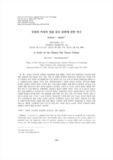

PARTNER
검증된 파트너 제휴사 자료
두룽족 여성의 얼굴 문신 문화에 관한 연구
방대한 850만건의 자료 중 주제별로 만들수 있는 최적의 산출물을 해피 캠퍼스에서 체험 하세요 전문가의 지식과 인사이트를 활용하여 쉽고 폭넓게 이해하고 적용할수 있는 기회를 놓치지 마세요
7 페이지
최초등록일 2023.07.31
최종저작일
2023.04

-
 * 본 문서는 배포용으로 복사 및 편집이 불가합니다.
* 본 문서는 배포용으로 복사 및 편집이 불가합니다.
미리보기
서지정보
· 발행기관 : 한국유화학회
· 수록지 정보 : 韓國油化學會誌 / 40권 / 2호
· 저자명 : 후어타오, 임희경
목차
요 약
Abstract
1. 서 론
2. 연구방법
3. 결과 및 고찰
3.1. 얼굴문신의 역사
3.2. 얼굴문신의 기능과 상징
3.3. 얼굴문신 시기
3.4. 얼굴문신 도안
3.5. 얼굴문신 방법
3.6 얼굴문신 문화의 영향
4. 결 론
References초록
문신은 인류에게 오랫동안 전승되어온 문화 형태다. 인류의 여러 문화권에서 전승되고 발전 해온 전통적인 문신 풍습은 역사, 예술, 사회, 등 다양한 분야에서 학술적으로 중요한 연구 가치를 가진 다. 두룽족은 중국 남서부 윈난(雲南)성과 근처 지역에 사는 소수 민족 중 하나로 안면문신을 위주로 하 는 ‘얼굴문신(文面)' 풍습을 가지고 있다. 중화인민공화국이 성립된 1949년 전까지도 원시사회 형태를 유지한 두룽족의 전통적 문화는 문자가 없는 구전(口傳)의 형태로 전해 졌으나 두룽족의 신비로운 문신 문화에 대한 보존자료가 없어 연구의 필요성이 요구된다. 따라서 본 연구는 근현대 문헌과 윈난성 지역 현장 탐사 두 가지 방법으로 수행되었다. 얼굴문신 풍습의 정확한 이유와 시기는 알 수 없으나 1966년 중국 문화 대혁명으로 금지되어서야 사라지게 되었다. 얼굴문신의 상징과 기능에 대해서는 현지 탐사과 근현대 학자들의 연구를 통해 크게 신앙숭배, 성년 의례, 심미 장식, 민족 사회 역사의 4가지로 나눌 수 있으며 문신을 하는 시기는 7∼8세 부터이다. 얼굴문신은 지역에 따라 상류 여성은 비교적 복잡한 도안 으로 구성되었으며, 하류 여성은 간단한 도안으로 구성되었다. 문신은 주로 친족이 시술하며 주로 대나 무 꼬챙이와 솥바닥에서 추출한 회즙 재를 재료로 사용한다. 현재 두룽족의 얼굴문신을 한 여성은 25명 미만으로, 대부분 고령화되어 있어 수십 년 안에 모두 사라질 것으로 보인다. 따라서 두룽족의 독특한 얼굴문신 문화에 대한 문서화가 시급하다.영어초록
A tattoo is a cultural form that has been handed down to mankind for a long time. Traditional tattoo customs that have been handed down and developed in the various cultures of mankind have the important value of academic research in various fields such as history, art, society, etc. The Derung people, one of the minorities living in Yunnan Province and nearby areas in the southwest of China, have 'facial tattoo' customs. The traditional culture of the Derung people, which had maintained the form of primitive society until 1949 when the People's Republic of China was established, was passed down through oral tradition, so there are no preserved materials about their tattoo culture, showing the need for research on the culture. Therefore, it was conducted in two ways: a research on modern and contemporary literature and a field trip to Yunnan Province. The exact reason and time of facial tattoo customs are unknown, but the customs disappeared after being banned in 1966 due to the Chinese Cultural Revolution. The symbols and functions of facial tattoos can be largely divided into four categories, including religious worship, coming-of-age ceremonies, aesthetic decorations, and ethnic and social history, through an on-site survey and research by modern and contemporary scholars. And, it is known that women of the Derung People get tattoos from the age of 7 to 8. The design of facial tattoos became more complicated for upper-class women and simpler for lower-class women depending on the area they live. Tattoos are mainly performed by relatives, and mainly bamboo skewers and lixivium extracted from the bottom of the pot are used as the materials. Currently, there are fewer than 25 women of the Derung people with facial tattoos, and most of them are elderly. Therefore, they seem to disappear altogether within a few decades. Therefore, it is urgent to have documentation on the unique facial tattoo culture of the Derung people.참고자료
· 없음태그
-
자료후기
-
자주묻는질문의 답변을 확인해 주세요

꼭 알아주세요
-
본 학술논문은 (주)코리아스칼라와 각 학회간에 저작권계약이 체결된 것으로 AgentSoft가 제공 하고 있습니다.
본 저작물을 불법적으로 이용시는 법적인 제재가 가해질 수 있습니다. -
해피캠퍼스는 구매자와 판매자 모두가 만족하는 서비스가 되도록 노력하고 있으며, 아래의 4가지 자료환불 조건을 꼭 확인해주시기 바랍니다.
파일오류 중복자료 저작권 없음 설명과 실제 내용 불일치 파일의 다운로드가 제대로 되지 않거나 파일형식에 맞는 프로그램으로 정상 작동하지 않는 경우 다른 자료와 70% 이상 내용이 일치하는 경우 (중복임을 확인할 수 있는 근거 필요함) 인터넷의 다른 사이트, 연구기관, 학교, 서적 등의 자료를 도용한 경우 자료의 설명과 실제 자료의 내용이 일치하지 않는 경우
“韓國油化學會誌”의 다른 논문도 확인해 보세요!
-
『산해경·오장산경』 수해 캐릭터 유형 특성에 관한 분석 연구 8 페이지
영상매체에 등장하는 캐릭터는 성향이나 역할에 따라 상징적인 의미가 다르다. 『산해경』은 B.C. 3~4세기경에 지어진 판타지 소설로 중국의 고대 소설에 등장하는 캐릭터는 유형에 따라 재해를 비롯한 재물, 질환 등 다양한 의미와 상징성을 가지고 있다. 중국인이 생각하는 동물의 상징성과 판타지 소설에 등장하는 캐릭터의 상징성, 그리고 형태적인 분석은 중국의 캐.. -
무중력 운동기구를 활용한 하이플랭크 운동의 효과성 검증 6 페이지
본 연구의 목적은 무중력 운동기구를 활용한 하이플랭크 운동 동작 차이에 따른 상완, 체간 및 코어근육의 근활성도를 비교하는 것이었다. 본 연구의 대상자는 20대 남성 6명을 대상으로 진행하였고(연 령, 23.00±0.73 세; 신장, 172.95±2.05 cm; 체중, 66.83±2.75 kg; 신체질량지수, 22.33±0.72 kg/m2), 4가지(HP,.. -
오일샌드 테일링 처리 동향연구 10 페이지
오일샌드 테일링의 방류 예정 소식은 찬반 논쟁을 이끌고 있다. 노천광 채굴연계 비투멘 추출공 정은 폐수의 발생이 필연적이며, 테일링 인공호수에 저장된다. 현재, 방치된 테일링 인공호수의 규모는 갈 수록 그 양이 커지고 있다. 테일링 처리가 매우 어려운 원인으로, 테일링 내의 MFT(mature fine tailings) 층의 생성과 연관이 깊다. 테일링 처.. -
간호대학생의 표준주의 지식과 표준주의 수행 간의 관계: 주관적 규범 매개효과 10 페이지
본 연구는 간호대학생의 표준주의 지식과 표준주의 수행과의 관계에서 주관적 규범의 매개효과 를 규명하기 위해 시행되었다. 연구의 대상자는 J도에 소재한 3개 대학교의 임상실습을 완료한 4학년 간호 학과 재학생 195명이다. 수집된 자료로 SPSS 25.0 프로그램을 이용하여 t-test, ANOVA, Pearson's correlation 및 multiple.. -
편백 오일의 항주름, 피부 장벽 및 보습능 평가 13 페이지
편백나무(Chamaecyparis obtusa)는 측백나무과에 속하며 우리나라 남쪽 지역에서 주로 잘 자 생한다. 편백나무의 목재는 재질이 우수하여 가구로서의 활용이 높으며 남은 목재, 가지, 잎은 정유 추출에 사용되고 있다. 편백 정유는 항염, 향균, 탈취, 진정 효능이 탁월한 것으로 알려져 있다. 본 연구는 이러한 편백나무의 잎에서 추출한 오일이 주름 ..
문서 초안을 생성해주는 EasyAI
